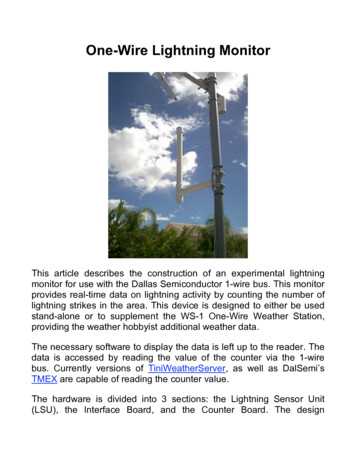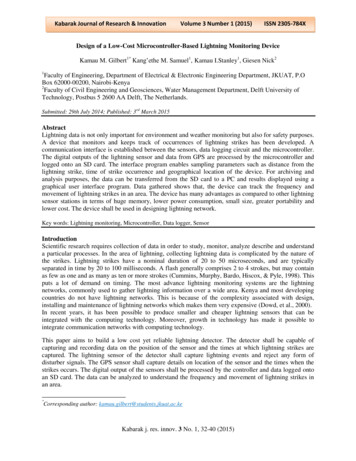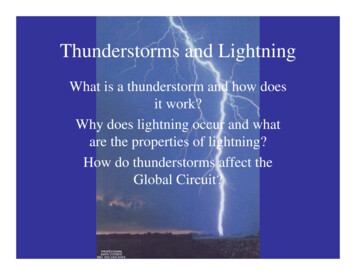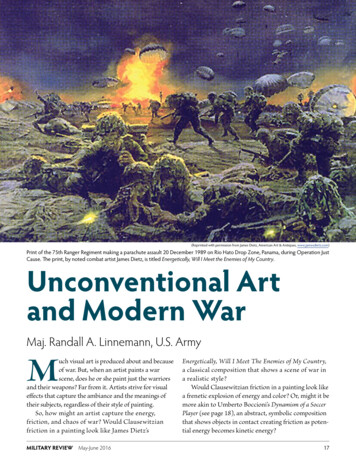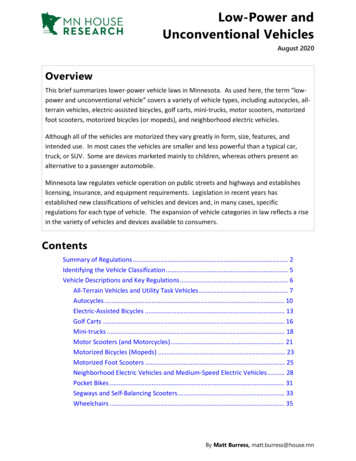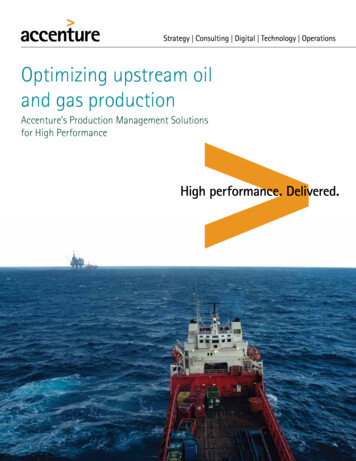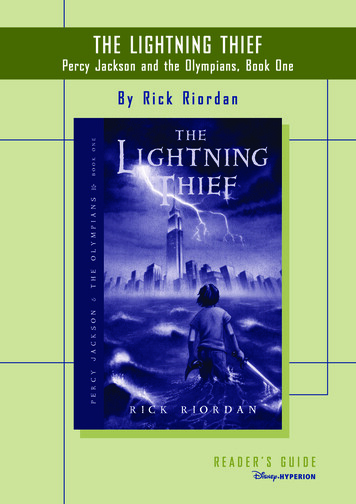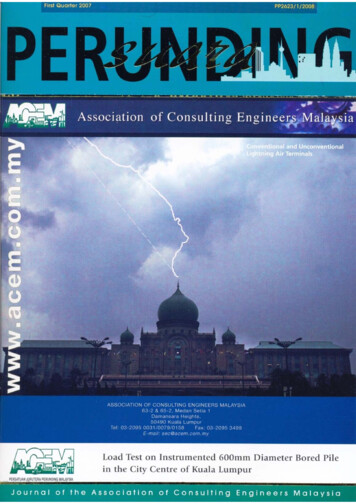
Transcription
Conventional and Unconventional LightningAir Terminals: An UpdateHARTONO Zainal Abidin, BSc, MIEEE and ROBIAH Ibrahim, BSc, MIEEE1.IntroductionThe standard also incorporates a new air terminal positioningmethod that is based on observations of lightning induceddamages in Malaysia. The description of this new method is asfollows:The lightning protection systems (LPS) used in this countryand around the world is basically divided into two types:a)Conventional or standard LPS i.e. that which complywith the technical standards/codes of practiceb)Unconventional or non-standard LPS i.e. those that donot comply with the standards/codes“Field data of damage caused by lightning flashes terminatingon structures (See Appendix G, Refs 2 & 3) identify the parts thatare vulnerable to strikes. The most vulnerable, associated withover 90% of observed lightning damage, are nearly always locatedon upper parts of structure, such as:The air terminals associated with the conventional LPS is theFranklin rod while those associated with the unconventional LPSare the so-called “active” air terminals e.g. the early streameremission (ESE) and the charge transfer system (CTS).In the last decade, the conventional LPS have been validatedin a number of studies conducted by lightning protection expertsaround the world. On the other hand, similar studies havediscredited the un-conventional LPS and this has led to theirrejection by various scientific and standards organizations. In2005, the International Conference on Lightning Protection (ICLP)issued a warning that the use of the unconventional LPS presentsa danger to the end users. Nevertheless, the local vendors andproponents of the unconventional LPS were not deterred by theseevents and continued to market their dangerous products to thepublic and even invented a new one.pointed apex roofs, spires and protrusions;(b)gable roof ridge ends; and(c)outer roof corners.Other areas of vulnerability, in decreasing order, are:This article is a follow-up on the paper presented by theauthors during the lightning protection forum organized by ACEMin January 2004. Readers can download the paper from etyalliance.org).2.(a)(d)the exposed edges of horizontal roofs, and the slanting andhorizontal edge of gable roofs ( 10%);(e)lower horizontal edges and vertical edges on outer-sides justbelow corners ( 5%);(f)flat surfaces near points and corners ( 3%); and(g)intruding surfaces and other surfaces, particularly flatsurfaces ( 1%).”To maximize the probability of intercepting the lightningstrikes, the air terminals must be positioned according to theabove high-risk locations.2.2 New IEC standard, IEC 62305Lightning protection standardsWork on the revised standard commenced in the late 1990sand it was finally published in February 2006 to replace the IEC61024. The new standard is divided into four parts:The recognized lightning protection standards frequentlyapplied in Malaysia are the MS-IEC 61024 (Malaysian/IEC),BS6651 (United Kingdom), NFPA780 (USA), AS/NZS 1768(Australia/New Zealand), and CP33 (Singapore). These standardsare regularly updated to incorporate the new findings on lightningprotection researches.In addition to the above, the vendors of the unconventionalLPS have introduced/proposed their own “product standards” suchas the French NFC 17-102. These so-called “standards” havealready been rejected by the scientific organizations in theircountry of origin.a)IEC 62305-1: General Principlesb)IEC 62305-2: Risk Managementc)IEC 62305-3: Physical damage to structures and life hazardd)IEC 62305-4: Electrical and electronic systems withinstructuresIn the IEC 62305-3, the PAM, RSM and FCM methods forpositioning the air terminals are also retained. In addition, a newparagraph on air terminal positioning, which is similar to that foundin the AS/NZS 1768(Int):2003 above has been added.2.1 AS/NZS 1768Work to revise this standard commenced in the late 1990sand the new interim standard, AS/NZS 1768(Int) 2003, waspublished in December 2003. The existing methods for positioningthe air terminals, namely the Protection Angle Method (PAM), theRolling Sphere Method (RSM) and the Faraday Cage Method(FCM), are still retained.The IEC 62305 is currently in the process of being evaluatedby the SIRIM Working Group on Lightning Protection to replacethe MS-IEC 61024.1
2.3 French ESE “standard”, NFC 17-102The following cases highlight the recent failures of the ESEair terminals in Malaysia:This “standard” was published in 1995 by GIMELEC, theassociation of French ESE manufacturers, in order to standardizethe manufacture, test and installation of the ESE air terminals. The“standard” has been copied by other non-French ESEmanufacturers e.g. Spain.4.1 Residential buildingsThe ESE air terminals are being used by some homedevelopers to protect detached houses and low rise apartmentblocks. However, the cases below show that the claimedenhanced zone of protection of the ESE air terminals had failed toprevent lightning from striking these buildings, either singular or ina cluster.The NFC 17-102 was criticized in 2002 in a report [1] by theFrench scientific agency, INERIS, for non-implementation by theESE manufacturers. Although the manufacturers have agreed torevise the document, no action has been taken so far. Hence theESE air terminals now in use worldwide have not only failed tocomply with the recognized national/international standards butthey also failed to comply with the manufacturers’ own standard.Case 1: Cluster application failure2.4 Proposed standard for the CTS systemBetween 1989 and 2005, the inventor of the CTS made fiveapplications to the NFPA to include the CTS in the NFPA780standard. All the applications were rejected because the inventorcould not provide the required scientific theory to support the CTS.The latest rejection [2] was made by the NFPA in 2005.2.5 Proposed standard for the Collection Volume Method(CVM)The CVM is a proprietary method for positioning theDynasphere air terminal, an active air terminal developed inAustralia. This method was included in the appendix of theAS/NZS 1768:1991 for information only. However, it was appliedin many countries for the installation of the Dynasphere airterminals. The CVM was also re-named as the Field IntensificationMethod (FIM) in 2002.Fig. 1: The damaged roof of a house that was struck by lightning.Field data collected in Malaysia over ten years on theapplication of the CVM/FIM failed to prove that the method is validfor air terminal positioning since most of the buildings that usedthe method had been struck and damaged by lightning.Consequently, the CVM/FIM was deleted from the AS/NZS1768(Int):2003.The CVM/FIM was also rejected by the NFPA [3] in 2004 forthe same reasons.3.Legality of advertising the ESE air terminalFollowing the rejection of the ESE technology by the NFPA in2000, several American ESE vendors brought the matter to courtalleging “unfair trading practices” on the part of their opponents.However, after lightning experts were called in to testify on theworkings of the ESE technology, the court issued a judgement [4]prohibiting the ESE vendors from claiming that their product canprovide a protection zone that is much bigger than that of theFranklin rod. The court had decided that the claims made by theESE vendors constituted false advertising and violated the USLanham Act.4.Fig. 2: Close-up view of the ESE air terminal (arrowed) on theadjacent house.Lightning struck the roof of a house which is adjacent toanother house that had been installed with an ESE air terminal.The roof was partially burnt as a result of the strike. This caseshows that the ESE air terminal is not capable of protectingclustered small buildings.Unconventional LPS and Public SafetyIn September 2005, the ICLP issued a warning [5] that theuse of the unconventional LPS posed a danger to the end userand general public. The warning highlighted the studies of ESE airterminal failures under real lightning conditions conducted in theUSA and Malaysia. Following this warning, ACEM had issued anadvisory (Ref: ACEM/sec/2005/13 dated October 27, 2005) to allits members to stop using the unconventional LPS.2
Case 2: Single application failureFig. 5: Minaret of Putrajaya Mosque. The claimed protection zoneis shown by the dotted line while the lightning strike location isshown by the arrow.Fig. 3: The fire damaged top floor of a house that was struck bylightning.Fig. 6: An ESE air terminal on the apex of the minaret (arrowed).Fig. 4: Close-up view of the ESE air terminal on the roof (arrowed).Lightning struck the roof of a house which had been installedwith an ESE air terminal. The roof and upper floor were badlyburnt as a result of the lightning strike. This case shows that theESE air terminal is not capable of protecting small buildings like adetached house.4.2 Putrajaya MosqueThe minaret of the mosque, completed in 1998, is a slim 116m high structure that was installed with a single ESE air terminalon the apex. According to the RSM, the sides of the minaret fromabout 50 m and above are exposed to lightning strikes and requireprotection.The protection provided by the ESE air terminal, according tothe NFC 17-102 “standard”, should be at its best since thediameter of the minaret is less than 10 m. However, in 2005,lightning struck the side of the minaret about 30 m below the apex.This clearly shows that the claimed enhanced zone of protectionfor the ESE air terminal is non-existent.Fig. 7: Close-up view of the lightning damaged section of theminaret (arrowed).The failure of the ESE air terminal to protect the minaretexplains why normal buildings are always struck by lightning onthe upper corners and edges. This is due to the fact that theselocations fall outside the hypothetical ESE protection zone.Installing the ESE air terminals on tall poles also has no effect onenhancing the protection zone.3
4.3 Prime Minister Department building, Putrajaya5.Local studies on the CTS and ESEThis large building has been installed with at least five ESEair terminals, one on the apex of the dome and four on ridge endsof the metal roofs below the dome. A photograph of a lightningstrike to the dome air terminal was recently captured by a newsphotographer.Studies in support of the CTS and ESE technologies weremade by University of Technology Malaysia (UTM) researcherssince 2003. Although they claimed to have found the proof forthese technologies, the findings were still inconclusive.5.1 CTS studiesAn analysis of the lightning path that terminated on the airterminal shows that the ESE principle is incorrect. If it was correct,then the lightning path would be approximately straight for severaltens of meters above air terminal since the streamer would bemoving towards the down leader.These studies were made jointly with researchers fromTelekom Malaysia Research and Development. The studies byRamli and Ahmad [6],[7] claimed to have validated the CTStechnology based on data obtained from the Malaysian lightningdetection network (LDN), lightning video recordings and lightningcurrent measurements made on the CTS air terminals. However, itwas found that the erroneous conclusions were made based onmisinterpretation of all the three data [8].The curved path of the lightning stroke just above the airterminal indicates that no streamer was emitted. In addition, novisible streamers were observed from the nearby ESE airterminals on the metal roofs. As already shown in the previousreport, a corner of the building next to one of the lower ESE airterminals had been struck by lightning.5.2 ESE studiesThese studies were conducted at the university’s high voltageinstitute, IVAT.In a study by Ngu and Darus [9], the ESE technology wasvalidated based on observed field data which consist of thenumber of observed lightning strike damages and selectedlightning counter readings. However, the data in this study werefound to be similar to the CVM/FIM data submitted by an ESEvendor to Standards Australia. Since the CVM/FIM has beenrejected by Standards Australia and the NFPA, the validity of thisstudy is questionable.In a study by Sidik and Ahmad [10], a new ESE air terminalequipped with a wind-driven electrostatic generator and a palmsized laser device was invented. They claimed [11] that the laserdevice is capable of attracting lightning strikes and that the airterminal operates on the CVM principle. They also claimed [12]that their invention need not be installed on the building forprotection against direct lightning strikes.Fig. 8: A photograph of lightning striking the ESE air terminal onthe Prime Minister Department building.(Photo credit: The Star Publications plc)Fig. 10: Side (left) and cross-section (right) views of the UTMinvented ESE air terminal. The box-shaped laser device is locatedbelow the wind-operated static generator. (Photo credit: UTM)Fig. 9: The dotted line represents the hypothetical path of the earlystreamer according to the ESE hypothesis.(Photo credit: The Star Publications plc)4
Several western studies have shown that the laser devicesrequired to ionize very long air paths to create conductingchannels for lightning are large and powerful; hence the claim thatthe palm-sized laser device can produce the same results in thefield is doubtful.The use of a wind-driven static generator means that thestreamer generation is only practical on windy days. The CVMclaim is unproven since the method had already been discreditedand rejected by Standards Australia and the NFPA.The last claim is also very doubtful since centrally positionedESE air terminals have repeatedly been shown to be ineffective inprotecting buildings from lightning strikes, what more an ESE airterminal that is positioned on one side of a large building.To avoid a controversy on the status of their ESE invention,the inventors have also claimed [13] that their invention is aconventional air terminal due to the presence of the Franklin rod atthe core.6.United States District Court of Arizona, Order No. CV 96th2796-PHX-ROS, dated 9 September 2005.[5]WARNING of the ICLP Scientific Committee, September2005.http://www.iclp-centre.org/view news.php?id 45[6]Ramli, A., et al, “Analysis of the Effectiveness of ChargeTransfer System intended for Lightning Prevention usingLightning Detection System, Lightning Video System andRogowski Coils”, Intl Conference on Lightning and StaticElectricity (ICOLSE2003), England, 2003.[7]Ramli, A. et al, “The Performance of Charge Transfer Systemagainst Lightning Rod at the Communication TowersAnalyzed by Using Lightning Video System and Rogowskicoils”, EMC Zurich Symposium, Switzerland, 2005.[8]Hartono, Z. A. and Robiah, I., “A review of studies on EarlyStreamer Emission and Charge Transfer System conductedin Malaysia”, EMC Zurich Symposium, Singapore, 2006.[9]Ngu, E. E. and Darus, A, “A Study on the ESE LightningProtection System”, summary of UTM research project, IVATwebsite, 2004.ConclusionSince 2004, no new evidence has been submitted to supportthe hypotheses behind the unconventional LPS. On the otherhand, more evidence has been presented to demonstrate theinefficacy of the unconventional LPS in field applications. TheICLP has issued a warning that the use of the unconventional LPSis dangerous.[10] Sidik, M. A. B. and Ahmad, H., “Study on the ESEMechanisms aided by Laser Radiation Ionisation Process”,summary of UTM research project, IVAT website, 2004.The revised national and international lightning protectionstandards have also included a new air terminal positioningmethod that will significantly improve the protection of buildingsfrom direct lightning strikes.[11] Sidik, M. A. B. and Ahmad, H., “Competitive tests betweentwo lightning air terminals”, UTM handout distributed atIENA2006 exhibition, Hamburg, 2006.[12] Sidik, M. A. B. and Ahmad, H., “A new lightning air terminalfor strategic structures using infra-red controller technology”,UTM handout distributed at MTE2007 exhibition, KualaLumpur, 2007.Studies conducted by local research institutions in support ofthe unconventional LPS have also been shown to be inconclusivewhile a new ESE air terminal developed by a local university isbased on discredited and unproven technologies.7.[4][13] Sidik, M. A. B. and Ahmad, H., “Modernised LightningProtection System (MLPS) with 5-in-1 Surge ProtectiveDevice”, UTM handout distributed at IENA2006 exhibition,Hamburg, 2006.AcknowledgementThe authors wish to thank The Star Publications PLC forpermission to use their award winning photograph of the lightningstrike to the Prime Minister Department building.8.References[1]Gruet, P, “Etude des Paratonnerres a Dispositif d’Amorcage:Ministere de l’Amenagement du Territoire et del’Environment”, INERIS, 2001.[2]NFPA Standards Council Decision (Final): D#05-11, January,2005.[3]NFPA Report of the Committee on Lightning Protection,NFPA 780-04-ROC, 2004.The authors of this paper have been conducting forensic analyseson lightning damaged electronic systems since 1980 and havebeen conducting research on the effects of lightning strikes tobuildings since 1990. They have published over two dozenscientific papers on these subjects in local and foreignconferences and journals. Their research works is highly cited inwestern scientific journals since 1995 and have been included inthe revised Australian and IEC lightning protection standards.For more information about the authors, enter “hartono” and“lightning protection” in GOOGLE. They can be contact as follows:E-mail: hartono@pc.jaring.myTelephone: 012-30599715
Lightning Safety Alliance website (www.lightningsafetyalliance.org). 2. Lightning protection standards The recognized lightning protection standards frequently applied in Malaysia are the MS-IEC 61024 (Malaysian/IEC), BS6651 (United Kingdom), NFPA780 (USA), AS/NZS 1768 (Australia/New Zealand), and CP33 (Singapore). These standards
